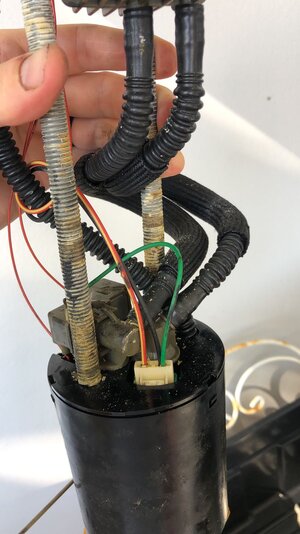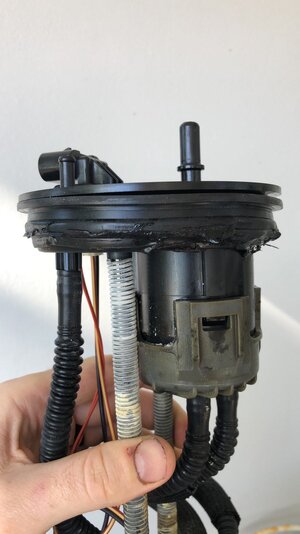explorationdomination
Member
Hi Everyone
I haven't used my ski in a long time. I am now getting it back up and running. I started it over the weekend and it ran fine after installing a new battery and fixing the battery terminals. However, I had a fuel low alarm go off but the fuel tank is pretty full. So I checked all the fuses and the 500-ohm resistor and they were all okay. I decided to open the fuel tank and check the level sensor. It turns out that something in the fuel has turned into sticky gum that has applied itself to the potentiometer on the level sensor and to all components of the fuel pump and sensor assembly. I have cleaned up the sender and it is measuring well again but I have some questions:
1. What is this sticky substance? It gets sticky when it is out of fuel and allowed to dry.
2. How can I remove it or clean it? Perhaps with clean, unleaded fuel and a paintbrush?
3. I think I should remove the old fuel and replace the fuel pump sediment filter (see picture) and fuel filter to ensure this doesn't go into my engine. Agree?
4. I did winterize the machine but it has been 4 years since I used the ski. I will change the engine oil, oil filter, and coolant. Please give me any suggestions on the best items to service before I take the ski back to sea to start fishing again. Do I need to do any of the following:
4.1 Grease any shaft bearings?
4.2 Check the injectors?
4.3 Check the water pump?
4.4 I am nervous about corrosion in the engine, manifold, supercharger, and jet pump. Should I be and what action could I take?
5. Someone prior to me used Sikaflex to seal the fuel tank gasket. Was this from the factory? It has made such a mess as it didn't dry on install. It's a hell of a thing to remove but I may try to, as its terrible for future maintenance.
Thank you for the help.
Ps. You can see the sticky gum in the photos on the vertical springs of the fuel pump / sensor assembly
I haven't used my ski in a long time. I am now getting it back up and running. I started it over the weekend and it ran fine after installing a new battery and fixing the battery terminals. However, I had a fuel low alarm go off but the fuel tank is pretty full. So I checked all the fuses and the 500-ohm resistor and they were all okay. I decided to open the fuel tank and check the level sensor. It turns out that something in the fuel has turned into sticky gum that has applied itself to the potentiometer on the level sensor and to all components of the fuel pump and sensor assembly. I have cleaned up the sender and it is measuring well again but I have some questions:
1. What is this sticky substance? It gets sticky when it is out of fuel and allowed to dry.
2. How can I remove it or clean it? Perhaps with clean, unleaded fuel and a paintbrush?
3. I think I should remove the old fuel and replace the fuel pump sediment filter (see picture) and fuel filter to ensure this doesn't go into my engine. Agree?
4. I did winterize the machine but it has been 4 years since I used the ski. I will change the engine oil, oil filter, and coolant. Please give me any suggestions on the best items to service before I take the ski back to sea to start fishing again. Do I need to do any of the following:
4.1 Grease any shaft bearings?
4.2 Check the injectors?
4.3 Check the water pump?
4.4 I am nervous about corrosion in the engine, manifold, supercharger, and jet pump. Should I be and what action could I take?
5. Someone prior to me used Sikaflex to seal the fuel tank gasket. Was this from the factory? It has made such a mess as it didn't dry on install. It's a hell of a thing to remove but I may try to, as its terrible for future maintenance.
Thank you for the help.
Ps. You can see the sticky gum in the photos on the vertical springs of the fuel pump / sensor assembly






